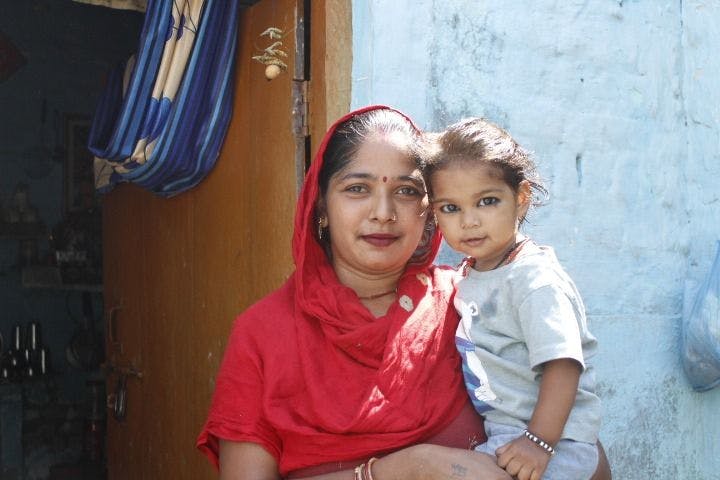Suvita

▲ Photo by Suvita
Suvita aims to increase the uptake of childhood vaccines in India. They do this via SMS vaccination reminders, and by working with local ‘immunisation ambassadors’ who ensure that local people are informed about vaccines. Vaccine coverage is relatively low in India, and increasing vaccine uptake is an extremely cost-effective way of avoiding deaths from preventable diseases.
What problem are they trying to solve?
Globally, over two million children die each year from vaccine-preventable diseases—despite the availability of low-cost vaccines (Brenzel et al. 2006). These diseases include diphtheria, tetanus, pertussis, measles, polio and TB. Despite its position as one of the world’s leading producers of vaccines, vaccine coverage in India is relatively low; coverage was estimated at 77% in 2019.1 There is also evidence that childhood vaccine coverage has dropped in India through the COVID pandemic (Jain et al. 2021).
While Suvita primarily focuses upon increasing childhood vaccination uptake in India, they also utilize their SMS reminders to increase attendance at antenatal care appointments. Attending antenatal visits is associated with better health outcomes for both mother and child. For example, women get tetanus shots, have their blood pressure checked (a check for pre-eclampsia), and are checked for infections that are especially dangerous during pregnancy—such as syphilis and TB (Kuhnt and Vollmer 2017).
What do they do?
Suvita uses two primary methods to increase uptake of childhood vaccinations in India. First, they utilize local immunisation ambassadors who share information with new parents in their community about local vaccine clinics. To identify these ambassadors, randomly selected members of the community are surveyed to identify opinion leaders. These individuals, who are identified as leading sources of information in the community, are then invited to volunteer as immunization ambassadors. If they accept, they are sent a sequence of SMSs containing immunization-related information. They then share this information with relevant members of their communities. This method has not yet been extensively studied (in the same way that SMS reminders have been) but existing results are very promising—a large study from J-PAL indicates that immunization ambassadors are highly effective (Banerjee et al., 2021).
The second method that Suvita uses is to send personalised SMS reminders to caregivers informing them when their child is due for a vaccination. In one of the two states in which Suvita works (Maharashtra), these SMS messages begin to be sent when the woman is pregnant, so are also used as a reminder to attend antenatal appointments. SMS reminders have been thoroughly studied, and there is good evidence that they increase attendance at vaccination and antenatal appointments (e.g. see Domek et al., 2019; Kazi et al., 2018).
Importantly, both the ambassador program and SMS reminders are extremely cheap. Our cost-effectiveness analysis indicates these interventions (acting to increase the percentage of children getting vaccinated in India) are extremely cost-effective. While our cost-effectiveness analyses are not meant to be taken literally, we estimate that approximately 52 children’s deaths are averted with a donation of $100,000—meaning that Suvita is one of our most highly-rated global health charities.
What would they do with more funding?
Suvita has a lot of room to scale up. They already have the necessary infrastructure to scale up in Maharashtra (at the moment, they only operate within a few districts of Maharashtra), so one of their first priorities is to scale up here. They also plan to scale up further in Bihar.
Beyond this, they plan to scale to other states within India—prioritizing the 6 states that account for 70% of under-vaccinated children (and then expanding to additional locations - in India or elsewhere - where their programs are likely to have the greatest impact). There is possibility for rapid growth, as Suvita are exploring pathways to combine work with the government or other groups (such as a telecoms company) to allow rapid expansion.
Importantly, the cost-effectiveness analysis uses their current data (in terms of the number of people that they reach, per dollar)—and shows that they are already highly cost-effective. However, they may become even more cost-effective as they scale: this is because a large proportion of their cost is in ‘setting up’ in new areas, for instance establishing the processes needed to continuously register new mothers.
Message from the organization
Co-founder Varsha Venugopal talks about Suvita on The 80,000 Hours Podcast.
Disclaimer: We do not have a reciprocal relationship with any charity, and recommendations are subject to change based on our ongoing research.
Notes
-
Meaning that around 77% of children were fully immunised (NFHS-5 2021) ↩